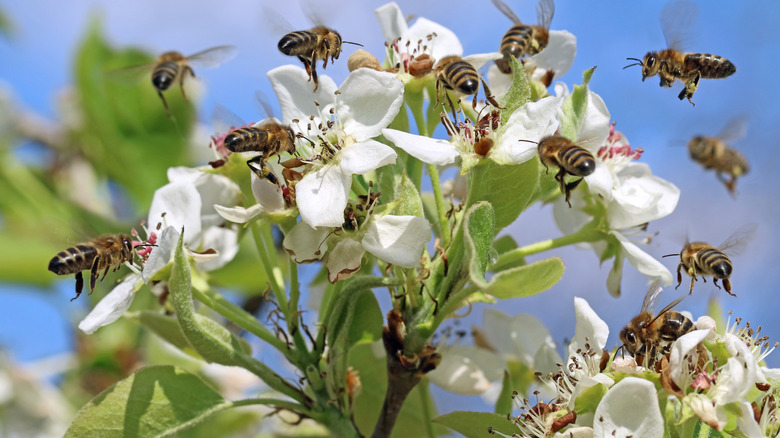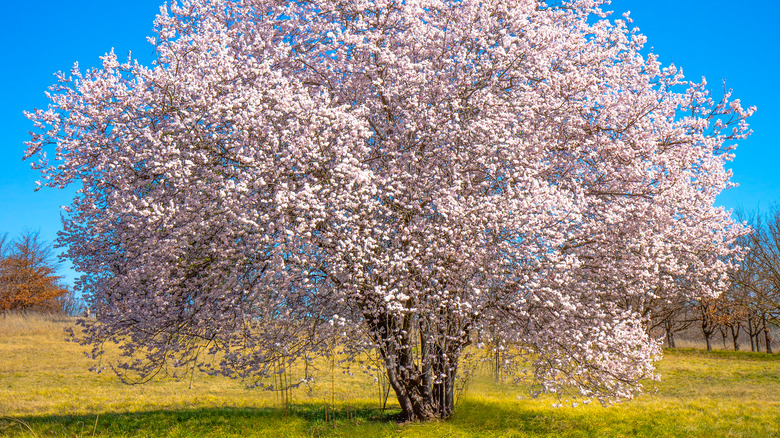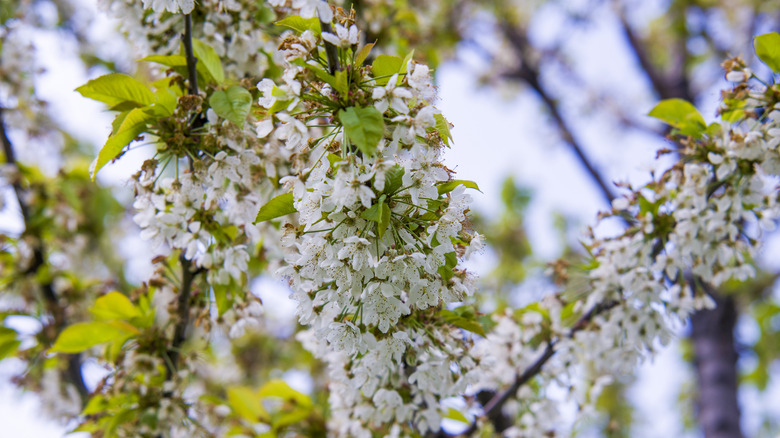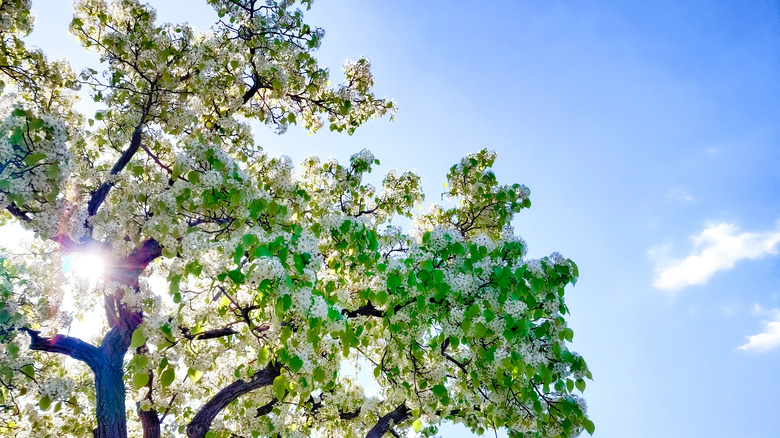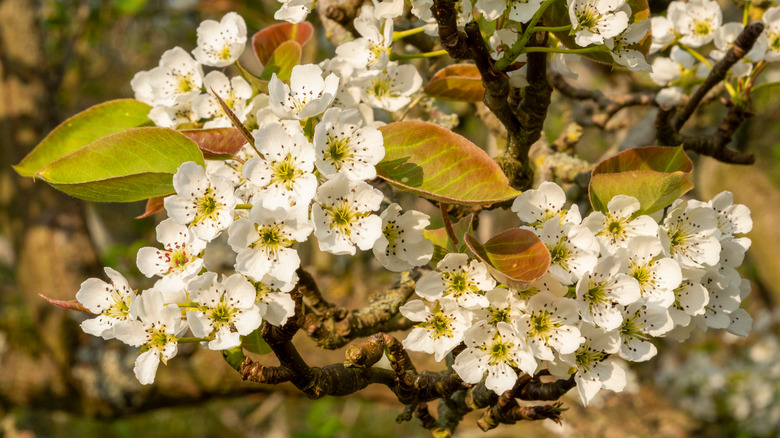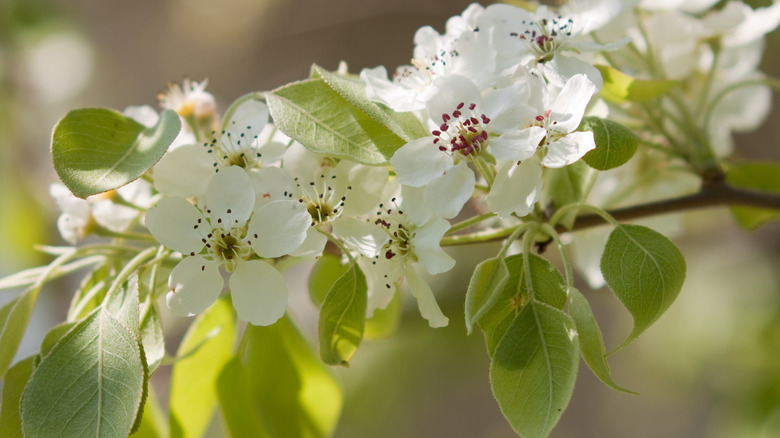Types Of Flowering Pear Trees That Are Good For Any Garden
Since the scenic views of ornamental trees are always lovely to behold, we thought it would be nice to write about the types of flowering pear trees. After all, who doesn't enjoy a dramatic profusion of showy foliage in spring? Flowering pear trees are desired for their glossy, ovate leaves, dark brown to light green trunks, and polychromatic transformation before they lose their leaves in the fall. However, be sure to check if any pear trees — especially those in the Pyrus calleryana genus and species — are considered invasive in your area before planting as they are in some regions (via Clemson News).
The varieties we have detailed are relatively low-maintenance and accommodate varying soil types and pH levels. But they do prefer full sun and organically rich, moist, well-draining soils. Since they play nice with other plants, you should have no problem incorporating them into your garden or landscape design. Watch out and take preventive measures against things like fire blight (like using neem oil), which Gardenerdy says these plants are susceptible toward, as well as limb breakage during windy conditions. Now that we have gone over the basics, let us jump into the nitty-gritty of flowering pear trees.
1. Manchurian pear
The manchurian flowering pear (Pyrus ussuriensis) is native to Asia but grows widely in Australia. If you desire a pleached garden, consider this shade tree because it has an upright trunk with horizontal branches, the experts over at Hello Hello Plant & Garden Supplies say.
The manchurian pear tree is pyramidal when young before attaining a dense rounded habit with age. It is also quite the performer in fall — flaunting its rich, dark red foliage without a care in the world.
Bloom Season: spring
USDA Growing Zone: 3 to 8
Growing Conditions: full sun to part shade
Soil Type: rich humus, well-draining
Size: 49 to 50 feet, 30 to 35 feet wide
2. Snow pear
Snow pear (Pyrus nivalis) is the most unique member of the Rosaceae family, as evidenced by its soft, silvery-green leaves and small, white-hued flowers that appear simultaneously to give it a striking appearance, via Gardenia.
Snow pear bears mildly sour-tasting fruits and has a wide conical habit and straight trunk. It does not require routine pruning, but look out for caterpillars, codling moths, bullfinches, aphids, pear rust, and pear scab.
Bloom Season: spring
USDA Growing Zone: 6 to 9
Growing Conditions: full sun
Soil Type: well-draining, rich, moist
Size: 20 to 30 feet tall, 15 to 20 feet wide
3. Evergreen pear
The evergreen pear (Pyrus kawakamii) joins our list of types of flowering pear trees. This variety is quite popular with homeowners — it has a wide, irregular crown that is significantly larger than the trunk of the tree. As Horticulture Unlimited notes, its leaves are glossy, light yellow-green in color, and oval-shaped with a pointed tip.
They transform into gorgeous shades of orange-red in the fall before falling off for a short time. The evergreen pear is a fruit tree, but it is rare to see the inedible pea-sized fruit it produces.
Bloom Season: winter to early spring
USDA Growing Zone: 8 to10
Growing Conditions: full sun to part shade
Soil Type: well-draining; sandy, clay
Size: 15 to 30 feet tall and wide
4. Asian pear
There is no doubt that the Asian pear tree (Pyrus pyrifolia) is famed for its delicious fruits, commonly known as apple pears, nashi pears, or papples. But a lesser-known fact is that they are also flowering pear trees that can make a great addition to any garden.
To grow Asian pear, plant them in the spring or fall, ensuring that they are about 30 feet apart, Garden Path recommends. Choose a soil type with a pH between 6 and 8 and make sure it receives eight hours of full sun daily.
Bloom Season: spring
USDA Growing Zone: 5 to 9
Growing Conditions: full sun
Soil Type: rich, well-draining, moderately loose
Size: 30 to 40 feet tall, 30 to 40 feet wide
5. Weeping silver pear
Weeping silver pear (Pyrus salicifolia 'pendula') is native to Russia and Armenia but was cultivated in Germany by botanist P.S. Pallas in 1780. It is a small but elegant deciduous tree that adapts to a broad range of garden sizes and landscape designs.
As part of the popular types of flowering pear trees, it impresses with long, weeping branches, slightly white flowers, and narrow, greyish-silver leaves, via Chew Valley Trees. Pyrus salicifolia 'pendula' is a slow grower.
Bloom Season: spring
USDA Growing Zone: 4 to 7
Growing Conditions: full sun
Soil Type: moist, well-draining soil
Size: 20 feet tall and wide at maturity
6. Southworth dancer pear
The serrated-edged, pale green leaves of southworth Dancer pear (Pyrus betulaefolia 'southworth dancer') transform into stunning shades of yellow in the fall. This ornamental tree is deciduous, producing silvery gray leaves after it sheds its foliage. We love it because it tolerates drought and dry conditions after it has been established, via Winter Hill Tree Farm.
Pyrus betulaefolia 'southworth dancer' makes a great feature tree for all garden styles.
Bloom Season: spring
USDA Growing Zone: up to 3
Growing Conditions: full sun to part shade
Soil Type: moist, rich, well-draining
Size: 22 feet tall, 13 feet wide at maturity

